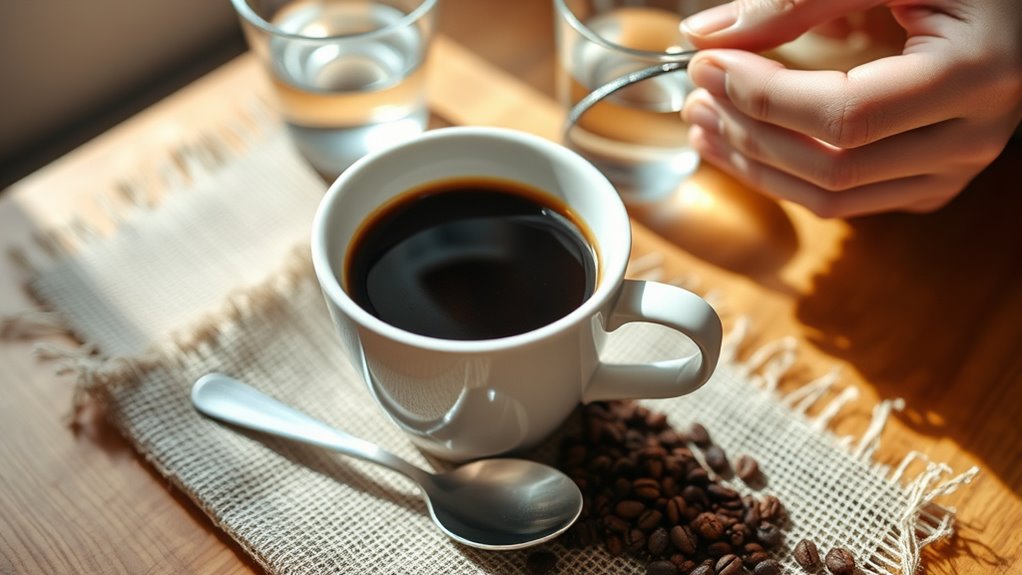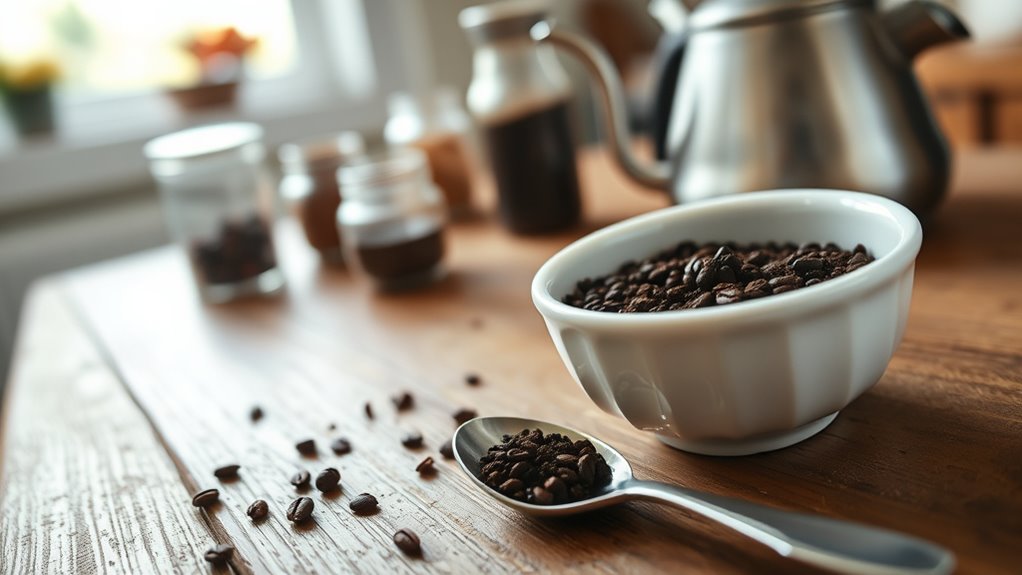To start coffee cupping at home, focus on your senses beyond just tasting. Smell the grounds before brewing for initial impressions, then inhale deeply after pouring hot water over the coffee. Take small sips, letting the flavor roll over your palate, and swirl the coffee in your mouth to unveil its full profile. Use precise measurements and consistent methods, and you’ll discover new layers of aroma and flavor. Keep exploring these sensory steps to deepen your coffee appreciation.
Key Takeaways
- Use a consistent cupping setup with precise measurements, a scale, and uniform cups to ensure accurate comparisons.
- Smell the grounds before brewing and inhale deeply after steeping to capture the coffee’s aromatic profile.
- Pour hot water over grounds, steep for about four minutes, then break the crust to release aroma and flavor.
- Take small sips, swirl in the mouth, and pay attention to the evolving flavors and sensations.
- Record sensory impressions in a notebook to track differences and refine your tasting skills over time.

If you’ve ever wanted to experience the art of coffee tasting without leaving your kitchen, coffee cupping at home is a perfect place to start. This process allows you to explore different beans, understand their unique flavors, and sharpen your palate. To do this effectively, you’ll need to master some tasting techniques and gather a few equipment essentials. With the right approach, you can turn an ordinary morning into an immersive sensory experience.
First, familiarize yourself with tasting techniques. These involve more than just sipping coffee; they require deliberate attention to each aspect of the aroma and flavor. Start by smelling the grounds before brewing to get initial impressions. Once brewed, lean in close to the cup, and inhale deeply to pick up the fragrance. Take small sips and let the coffee roll over your palate, paying attention to the taste, body, acidity, and aftertaste. Swirling the coffee gently in your mouth helps release more flavors, giving you a complete sensory profile. By practicing these techniques regularly, you’ll develop a keen sense for distinguishing different beans and roast levels.
Now, let’s talk about equipment essentials. You don’t need fancy gear to start, but some basic items will *considerably* improve your cupping experience. First, you’ll need a scale to measure coffee and water precisely, ensuring consistency. A grinder is essential; opt for a burr grinder to achieve uniform grounds. Use a kettle with a gooseneck spout for controlled pouring, which helps manage extraction. Invest in a few cupping bowls or small cups—these should be identical in size and shape for fair comparisons. A spoon, preferably a cupping spoon with a round bowl, makes it easier to taste and evaluate the coffee. Finally, keep a notebook handy to jot down your impressions, including aroma, flavor notes, and overall impression of each sample.
Preparation is key to successful cupping. Measure out your coffee—about 8 to 10 grams per cup—and grind it to a coarse consistency, similar to sea salt. Pour hot water (just off the boil) over the grounds, and let them steep for about four minutes. During this time, you’ll notice the grounds forming a crust, which you can gently break with the back of your spoon to release more aroma. After breaking the crust, allow the coffee to cool slightly before tasting. This step ensures your palate isn’t overwhelmed by heat and allows the flavors to fully develop.
Incorporating proper tasting techniques and equipment essentials makes home coffee cupping not only educational but also enjoyable. With patience and practice, you’ll refine your senses and deepen your appreciation for each unique coffee bean—making every cup a journey of discovery.
Frequently Asked Questions
What Equipment Is Essential for Home Cupping?
For home cupping, you need essential equipment like a cupping spoon, a grinder, and cupping bowls, ensuring your tools align with proper cupping terminology. Calibration of your grinder guarantees consistent grind size, vital for accurate tasting. You might also want a kettle, a scale, and a timer. These tools help you develop a refined palate, making your cupping sessions more effective and enjoyable, just like professional baristas do.
How Do I Store Coffee Beans for Cupping?
You might think storing coffee beans is complicated, but it’s simple—just keep them fresh! Use airtight storage containers to lock in coffee freshness and prevent exposure to air, light, and moisture that degrade flavor. Store your beans in a cool, dark place away from heat sources. This way, your beans stay flavorful for your cupping sessions, ensuring every brew is as aromatic and vibrant as the first roast.
Can I Use Instant Coffee for Cupping?
Using instant coffee for cupping isn’t ideal because it lacks the complexity of freshly ground beans. Instant coffee is processed differently, often missing the nuanced aromas and flavors you want to evaluate. For proper cupping, stick to brewing methods like pour-over or French press with freshly ground beans. This guarantees you get an accurate sensory experience, revealing the true character of the coffee, which instant coffee simply can’t provide.
How Often Should I Practice Cupping at Home?
You should practice cupping at home about once a week to improve your tasting frequency and develop your skills. Consistent practice helps you better identify flavors and nuances in different coffees. Don’t overdo it—regular, focused sessions are more effective than infrequent, lengthy ones. As you gain experience, you can increase or adjust your tasting frequency to match your skill development goals, ensuring steady progress.
What Are Common Mistakes to Avoid During Cupping?
When cupping, avoid common mistakes like using the wrong grind size, which can skew your results, and neglecting water temperature, affecting extraction. Make sure to grind consistently and keep water around 200°F for ideal brewing. Don’t rush the process or compare coffees immediately after brewing. Instead, take your time to smell, taste, and adjust. Staying mindful of these details helps you develop better sensory skills and enjoy more precise tastings.
Conclusion
Now that you’ve explored coffee cupping at home, you’re just a few gentle steps away from perfecting your palate. Think of it as a cozy adventure, where each sip brings a new discovery. With patience and curiosity, you’ll find yourself savoring every nuance like a seasoned barista. So, keep brewing, smelling, and tasting—your coffee journey is just beginning, and the best is yet to come. Cheers to your flavorful explorations!









